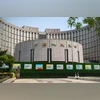By Bloomberg News
China boosted its cash injection into the banking system via a recently launched policy tool, in a move designed to ensure sufficient liquidity amid a surge in local government bond sales.
The People’s Bank of China conducted 800 billion yuan ($111 billion) of outright reverse repurchase agreements in November, according to a statement Friday, exceeding the 500 billion yuan injected last month. The contracts are for three months and are aimed at safeguarding the availability of “reasonably ample” liquidity in the banking system, it said.
In a separate statement, the central bank said it bought a net 200 billion yuan of sovereign bonds from dealers in November. The aim was also to ensure plentiful cash supply, according to the PBOC.
The injection expands an effort to ease the funding pressure that had been building in the market after China kicked off a $1.4 trillion program to help local governments cope with their off-balance-sheet debt by allowing them to sell more bonds. As a result, banks — the main investors in these securities — are in need of more cash to absorb the higher debt supply while at the same time continuing to lend to consumers and businesses.
graph
Also Read
The PBOC will likely need to take further action — potentially by cutting the amount of cash banks must set aside in reserves — to avoid a liquidity squeeze in the coming months. A total of 2.4 trillion yuan in loans extended through the medium-term lending facility will mature in December and January, when the demand for cash usually increases due to public holidays.
PBOC Governor Pan Gongsheng previously said it could cut the reserve requirement ratio by 25 to 50 basis points by the end of the year depending on liquidity conditions, following a 50-basis-point reduction in September.
The operation suggests the need that remains “to inject liquidity amid strong government bond issuance and ahead of year-end,” said Becky Liu, head of China macro strategy at Standard Chartered Plc. “We still see a good possibility for cutting the RRR before year-end, and a rate cut once yuan pressure eases.”
What Bloomberg Economics Says ...
“We expect the central bank to use a range of tools to keep the banking sector flush. PBOC Governor Pan Gongsheng has flagged a potential reduction in the reserve requirement ratio by year-end. We also expect the PBOC to use medium-term lending facilities to provide one-year funds and reverse repos to add short-term cash, and to buy government bonds.”
— David Qu, economist
China’s economy is on the mend thanks to a stimulus blitz unleashed at the end of September, with consumption boosted by government subsidies. While the country is expected to achieve this year’s growth target of around 5%, it’s still contending with longer-term problems including entrenched deflation and a potential trade war with the US after the reelection of Donald Trump.
The PBOC has embarked on overhauling its toolbox earlier this year in order to influence market borrowing costs more effectively and better coordinate with fiscal policymakers. As part of the shift, it began trading government bonds in August and launched the outright reverse repo tool last month.
These programs are expected to play a major role in managing liquidity in the future. At the same time, older tools like the medium-term lending facility are being downplayed.
The PBOC drained a net 550 billion yuan of one-year cash in November via the medium-term lending facility, which is being replaced by a shorter-term rate as the main lever to guide markets.
Some analysts have argued it was possible the PBOC may have bought local government bonds via the outright reverse repo program in October. The tool allows the PBOC to purchase securities including sovereign bonds, local government notes and corporate debt from financial institutions, and sell them back at an agreed time in the future.

)